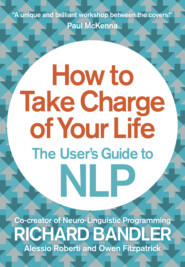По всем вопросам обращайтесь на: info@litportal.ru
(©) 2003-2025.
✖
Richard Bandler's Guide to Trance-formation: Make Your Life Great
Автор
Год написания книги
2019
Настройки чтения
Размер шрифта
Высота строк
Поля
These are the things that set people free.
Exercise 1: The Meta Model
1 Refer to Resource File 4. Begin to practice noticing Meta Model patterns, spending two days on each. Pay special attention to the language you hear, noting the violations that occur. Television interviews with politicians are a rich source of Meta Model violations.
2 As you become more familiar with each pattern, jot down some of the challenges you would use in a real-time situation.
Exercise 2: The Meta Model
1 Working with a partner, discuss a real or imaginary problem. The listener notes Meta Model violations and challenges them, always seeking to recover information that has been deleted, distorted, or generalized.
2 Change places and repeat.
Exercise 1: The Milton Model
1 Review the examples given in Resource File 5, then create at least twenty of your own.
Exercise 2: The Milton Model
1 Decide on an outcome you would like for a client. Choose three to five Milton Model patterns, and create a conversational induction by linking the patterns with conjunctions or temporal connections. Repeat the pattern three times, so that each induction comprises between nine and fifteen examples of hypnotic language.
Five DIRECTIONS OR OUTCOMES (#ulink_0aa9b464-8a9f-560a-a124-480197ded339)
Planning to Succeed
ALL THE SUCCESSFUL PEOPLE I’ve studied share two important qualities: they know where they’re going, and they’re prepared to put in whatever work is necessary to get them from where they are now to where they want to be. This is what I would like readers of this book to develop, both for themselves and for the people they will be able to help: their friends, family, and clients.
Great golfers practice, practice, practice. Baseball players spend their time in the batting cages, having people pitch to them for hour upon hour upon hour. Professional musicians spend more time practicing than they do performing. I worked with a close-up card magician once, and he would sit there doing the same trick again and again and again. Interestingly, whenever any of these people make a mistake or fall short of their goal, they never complain that they were doing it wrong or underperforming, or failing—they simply laugh or shrug and do it again until they get it right.
The magician’s strategy was to make a movie of how his hands were supposed to move when the trick worked perfectly. Then he’d move around and step into the image—slide his hands into the hands that could do the trick perfectly—and try to replicate the action.
Most successful athletes do this, or something similar. They know what perfection looks like. They see it being done perfectly, then step inside it, and carry out the action, knowing they’ve succeeded when they get a good feeling.
It’s important to realize that they don’t feel bad when they don’t get it right; they simply don’t feel anything at all. But when they start to get it right, they feel good, and the better they get, the better they feel—so it builds an addiction to trying. Even if they only get it right one out of ten times, that feeling makes it worthwhile. They push right through the nine times for the buzz of the tenth. After a while, they get it twice out of ten, then four times, and so on, and they keep going because they become hooked on the good feeling.
By contrast, many people just feel bad whenever what they decide should happen doesn’t work out that way. This is why I often say, “Disappointment takes adequate planning.”
Unlike the failure-punishment approach to learning, attaching good feeling to action builds a feed-forward loop that gets people to improve their activity based on feeling better and better. When this strategy is properly in place, people don’t mind not getting it right the first time, or even the fourth time, because they know how good it will feel when it does work out.
What works for athletes or magicians works for all of us. We’re all playing games of some kind or another—work games, relationship games, parenting games, recreational games—and it’s as well we learn to play them to the best of our ability. We need to move in useful, appropriate, and desirable directions. If we try to get through by avoiding discomfort or pain, we’re walking backward, and we don’t know what we’re going to fall into. If we build feed-forward loops so we’re moving toward pleasure rather than away from pain, we’re walking toward something we want, and we know in which direction we’re going.
Many Neuro-Linguistic Programmers talk about getting good outcomes. I talk about setting good directions. It’s an important distinction. I want people to have a direction so they keep going. I want them to become involved in the process of living. Whenever people come to me and say, “I want to be happy,” I always say, “I’m sorry all the Seven Dwarf jobs are gone. You’re going to have to be a little more specific than that.”
You can’t just be happy, but you can learn to do things happily. Living happily entails paying attention to and enjoying the process of doing whatever it is you happen to be doing. It’s not just that something goes bing! and suddenly you’re happy. You learn to be happy by following the old adage about stopping to smell the roses, but you have to enjoy looking at them, and touching them, and walking by them, and everything else about them. You can learn to enjoy everything. You can learn to enjoy sleeping, and waking up, and making breakfast, and going to work. The more things you make pleasant, the happier life will be.
One of my approaches to help people improve their lives is to get them into a light trance, create good feelings for them, and then aim them in a direction where they can see themselves behaving differently. Everyone can learn to behave differently to some degree or other. And everyone can learn to create good feelings. They first have to know what this will be like; then and only then can they go about planning how to do it for themselves.
Вы ознакомились с фрагментом книги.
Приобретайте полный текст книги у нашего партнера:
Приобретайте полный текст книги у нашего партнера:








